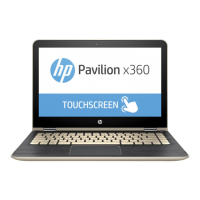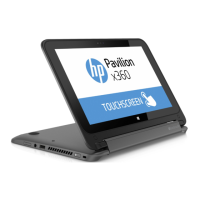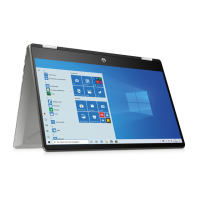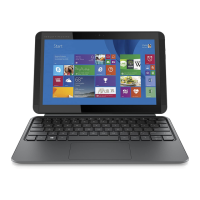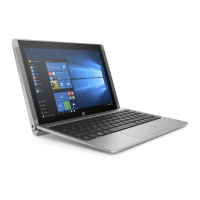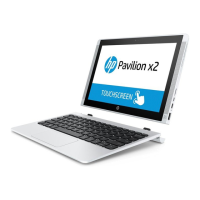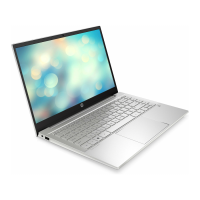Do you have a question about the HP Pavilion x360 Convertible and is the answer not in the manual?
Details specifications for Intel Braswell and Broadwell processors, including clock speed and core count.
Lists internal graphics capabilities for Intel Pentium and Celeron processors.
Describes the 11.6-inch HD display panel, including resolution, brightness, and aspect ratio.
Details system memory types, including DDR3L support and SODIMM slot availability.
Outlines support for 2.5-inch hard drives and M.2 SATA SSDs.
Covers integrated webcam, microphones, speakers, and audio enhancement technologies.
Lists all external ports including USB, HDMI, and audio jacks.
Describes the full-size keyboard, touchpad features, and stylus support.
Details AC adapter specifications and battery types.
Covers security features like Kensington lock slot and TPM.
Lists the preinstalled operating system versions available.
Identifies user-replaceable parts for servicing.
Identifies and describes components located on the right side of the computer.
Identifies and describes components located on the left side of the computer.
Identifies and describes components located on the bottom of the computer.
Identifies and describes components of the display assembly.
Identifies and describes components on the top surface of the computer.
Lists and illustrates the main internal components of the computer.
Details the different types of hard drives and SSDs with their part numbers.
Lists and illustrates the individual parts that make up the display assembly.
Lists various accessory parts such as AC adapters and power cords.
Lists the essential tools needed to perform component removal and replacement.
Provides general guidelines and precautions for disassembling and reassembling the computer.
Offers guidance on handling internal cables and connectors to prevent damage.
Provides precautions for safely handling hard drives and solid-state drives.
Explains electrostatic discharge (ESD) and how to prevent damage to components.
Provides instructions for safely packaging and transporting computer components.
Outlines best practices for setting up a safe and effective service workstation.
Overview of procedures for replacing various computer components.
Step-by-step instructions for removing and replacing the top cover assembly.
Procedure for removing and replacing the computer's TouchPad.
Instructions for removing and replacing the hard disk drive.
Procedure for removing and replacing the M.2 solid-state drive.
Instructions for removing and replacing the USB/audio jack board on the right side.
Instructions for removing and replacing the USB/card reader board on the left side.
Procedure for removing and replacing the internal speakers.
Detailed steps for removing and replacing the main system board.
Instructions for removing and replacing the system memory modules.
Procedure for removing and replacing the wireless local area network module.
Instructions for removing and replacing the heat sink assembly.
Step-by-step guide for removing and replacing the computer battery.
Procedure for removing and replacing the entire display assembly.
Instructions for removing and replacing the power button board.
Procedure for removing and replacing the power connector cable.
Instructions on how to access the BIOS setup utility.
Information on how to download and install BIOS updates.
Steps to check the current BIOS version installed on the computer.
Guidance on downloading BIOS updates from the HP website.
Instructions on how to access the BIOS setup utility for Windows 10.
Information on how to download and install BIOS updates.
Steps to check the current BIOS version on the computer.
Guidance on downloading BIOS updates via HP Support Assistant.
Procedure for synchronizing detachable keyboards with tablets.
Methods for creating recovery media and system backups.
Utilizing Windows built-in tools for system restore points and backups.
Overview of various system recovery and restore options.
Detailed guide on using HP Recovery Manager for system recovery.
Important information and prerequisites before starting recovery procedures.
Methods for creating recovery media and system backups for Windows 10.
Utilizing Windows tools for system restore points and backups.
Overview of system recovery and restore options for Windows 10.
Detailed guide on using HP Recovery Manager for system recovery.
Important information and prerequisites before starting recovery procedures.
Instructions on how to start the HP PC Hardware Diagnostics UEFI tool.
Guide on downloading the HP PC Hardware Diagnostics tool to a USB drive.
Lists general specifications for the computer, including dimensions and power.
Details technical specifications for 1-TB and 500-GB hard drives.
Provides technical specifications for 128-GB and 256-GB M.2 solid-state drives.
Lists technical specifications for the 11.6-inch HD+ display panel.
General requirements for power cord sets applicable globally.
Lists accredited agencies and notes for power cord sets by country/region.
Details the types of nonvolatile memory, their purpose, and how data is stored.
FAQ section covering BIOS settings, UEFI vs. legacy BIOS, and memory.
Information about HP Sure Start technology for BIOS protection.
Details specifications for Intel Braswell and Broadwell processors, including clock speed and core count.
Lists internal graphics capabilities for Intel Pentium and Celeron processors.
Describes the 11.6-inch HD display panel, including resolution, brightness, and aspect ratio.
Details system memory types, including DDR3L support and SODIMM slot availability.
Outlines support for 2.5-inch hard drives and M.2 SATA SSDs.
Covers integrated webcam, microphones, speakers, and audio enhancement technologies.
Lists all external ports including USB, HDMI, and audio jacks.
Describes the full-size keyboard, touchpad features, and stylus support.
Details AC adapter specifications and battery types.
Covers security features like Kensington lock slot and TPM.
Lists the preinstalled operating system versions available.
Identifies user-replaceable parts for servicing.
Identifies and describes components located on the right side of the computer.
Identifies and describes components located on the left side of the computer.
Identifies and describes components located on the bottom of the computer.
Identifies and describes components of the display assembly.
Identifies and describes components on the top surface of the computer.
Lists and illustrates the main internal components of the computer.
Details the different types of hard drives and SSDs with their part numbers.
Lists and illustrates the individual parts that make up the display assembly.
Lists various accessory parts such as AC adapters and power cords.
Lists the essential tools needed to perform component removal and replacement.
Provides general guidelines and precautions for disassembling and reassembling the computer.
Offers guidance on handling internal cables and connectors to prevent damage.
Provides precautions for safely handling hard drives and solid-state drives.
Explains electrostatic discharge (ESD) and how to prevent damage to components.
Provides instructions for safely packaging and transporting computer components.
Outlines best practices for setting up a safe and effective service workstation.
Overview of procedures for replacing various computer components.
Step-by-step instructions for removing and replacing the top cover assembly.
Procedure for removing and replacing the computer's TouchPad.
Instructions for removing and replacing the hard disk drive.
Procedure for removing and replacing the M.2 solid-state drive.
Instructions for removing and replacing the USB/audio jack board on the right side.
Instructions for removing and replacing the USB/card reader board on the left side.
Procedure for removing and replacing the internal speakers.
Detailed steps for removing and replacing the main system board.
Instructions for removing and replacing the system memory modules.
Procedure for removing and replacing the wireless local area network module.
Instructions for removing and replacing the heat sink assembly.
Step-by-step guide for removing and replacing the computer battery.
Procedure for removing and replacing the entire display assembly.
Instructions for removing and replacing the power button board.
Procedure for removing and replacing the power connector cable.
Instructions on how to access the BIOS setup utility.
Information on how to download and install BIOS updates.
Steps to check the current BIOS version installed on the computer.
Guidance on downloading BIOS updates from the HP website.
Instructions on how to access the BIOS setup utility for Windows 10.
Information on how to download and install BIOS updates.
Steps to check the current BIOS version on the computer.
Guidance on downloading BIOS updates via HP Support Assistant.
Procedure for synchronizing detachable keyboards with tablets.
Methods for creating recovery media and system backups.
Utilizing Windows built-in tools for system restore points and backups.
Overview of various system recovery and restore options.
Detailed guide on using HP Recovery Manager for system recovery.
Important information and prerequisites before starting recovery procedures.
Methods for creating recovery media and system backups for Windows 10.
Utilizing Windows tools for system restore points and backups.
Overview of system recovery and restore options for Windows 10.
Detailed guide on using HP Recovery Manager for system recovery.
Important information and prerequisites before starting recovery procedures.
Instructions on how to start the HP PC Hardware Diagnostics UEFI tool.
Guide on downloading the HP PC Hardware Diagnostics tool to a USB drive.
Lists general specifications for the computer, including dimensions and power.
Details technical specifications for 1-TB and 500-GB hard drives.
Provides technical specifications for 128-GB and 256-GB M.2 solid-state drives.
Lists technical specifications for the 11.6-inch HD+ display panel.
General requirements for power cord sets applicable globally.
Lists accredited agencies and notes for power cord sets by country/region.
Details the types of nonvolatile memory, their purpose, and how data is stored.
FAQ section covering BIOS settings, UEFI vs. legacy BIOS, and memory.
Information about HP Sure Start technology for BIOS protection.
| Operating System | Windows 10 or Windows 11 |
|---|---|
| Category | Laptop |
| Convertible | Yes |
| Graphics | Intel UHD Graphics |
| Series | Pavilion |
| Ports | USB Type-A, HDMI, headphone/microphone combo jack |
| Wireless Connectivity | Bluetooth |
| Processor | Intel Core i5 or i7 |
| RAM | 8GB or 16GB |
| Storage | 256GB, 512GB, or 1TB SSD |



